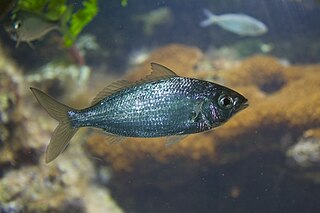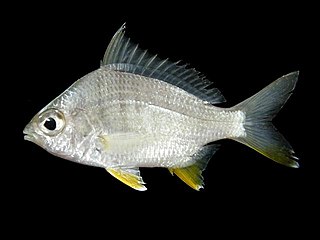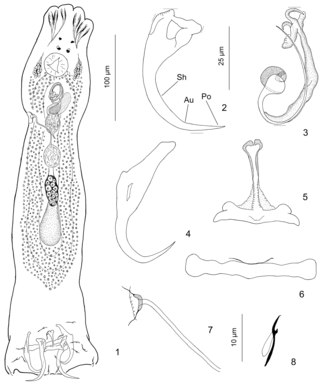
The mojarras are a family, Gerreidae, of fish in the order Perciformes. The family includes about 53 species found worldwide in tropical and warm temperate regions. They mostly inhabit coastal salt and brackish waters, although some occur in fresh water.

Lithognathus is a genus of marine ray-finned fish belonging to the family Sparidae, which includes the seabreams and porgies. Species in this genus are given the common name of steenbras. The genus is found in the Eastern Atlantic Ocean from southwestern Europe to South Africa and into the southwestern Indian Ocean.

Percoidea is a superfamily of fish of the order Perciformes. The superfamily includes about 3,374 species.

The saddled seabream, also called the saddle bream or oblade, is a species of ray-finned fish belonging to the family Sparidae, which includes the seabreams and porgies. It is the only species in the monospecific genus Oblada. This species is found in the Eastern Atlantic Ocean. It is an important food fish within its range.
Silver biddies, also spelled silver-biddies, is a name used to refer to some bony fishes belonging to the family Gerreidae in the order Perciformes. They are also known as jerki (Sin) or mudro (Bal). Silver biddies are known as blanches in French and mojarras in Spanish.

Parequula melbournensis, the silverbelly, Melbourne silver biddy or silver biddy, is a species of ray-finned fish in the family Garreidae, the mojarras. The species was first described by Francis de Laporte de Castelnau in 1872. It is the only member of the monotypic genus Parequula erected by Franz Steindachner in 1879. It is native to the coastal waters of southern Australia at depths from 3 to 100 m. This species can reach 22 cm (8.7 in) in total length.

Eucinostomus is a genus of ray-finned fish in the family Gerreidae (mojarras). They are native to the Atlantic and Pacific coasts of the Americas.

Eugerres is a genus of ray-finned fish in the family Gerreidae, the mojarras. The genus was erected by David Starr Jordan and Barton Warren Evermann in 1927. They are native to the Atlantic and Pacific coasts of the Americas, occurring mainly in salt and brackish waters, but may enter fresh water. The genus also includes one strict fresh water species, E. mexicanus, native to southern Mexico and Guatemala

Gerres is a genus of mojarras found mostly in coastal regions from the eastern Atlantic Ocean through the Indian Ocean to the western Pacific. A single species, G. simillimus, is from the East Pacific. They mainly inhabit salt and brackish waters, but will enter fresh water. At least one species, Gerres cinereus, displays an ability akin to gyroscopic stability, allowing it to remain in a remarkably static spatial position relative to the water flowing around it.

Pempheris is a genus of sweepers native to the Atlantic, Indian and Pacific Ocean.
The golden mojarra is a species of mojarra native to the eastern Pacific Ocean, where it is found from Costa Rica to the northern coast of Peru. This species grows to a length of 15 cm (5.9 in). This species is important to local peoples as a food fish. It is the only known member of its genus. This species was first formally described as Gerres aureolus in 1882 by David Starr Jordan (1851-1931) and Charles Henry Gilbert (1859-1928) with the type locality given as the Pacific Ocean at Bahia Matanhen, Nayart in Mexico. In 1994 it was placed in the genus Diapterus by Gerald R. Allen and D. Ross Robertson and after a review in 2014 it was placed in the monotypic genus Deckertichthys. The name of this genus honours Gary Dennis Deckert and compounds his surname with the Greek for fish, ichthys. Deckert was the first to recognise that D. aureolus was distinctive and has made a significant contribution to the study of the mojarras.

The Diplectanidae are a family of monopisthocotylean monogeneans. They are all parasitic on the gills of fish. Diplectanids are small animals, generally around 1 mm in length. As parasites, they can be extremely numerous, up to several thousand on an individual fish.

Gerres erythrourus the deep-bodied mojarra, also known as the short silverbiddy or short silverbelly, is a species of ray-finned fish from the family Gerreidae, a mojarra. It is native to marine and brackish waters of coastal waters of the Indian Ocean and the western Pacific Ocean, far towards Vanuatu. It inhabits estuaries, coastal waters and lagoons. This species can reach a length of 30 cm (12 in), with the average of 25 cm (9.8 in). This species is important to local commercial fisheries in many tropical countries.
Eucinostomus argenteus, the spotfin mojarra or silver mojarra, is a species of fish belonging to the family Gerreidae. The name spotfin mojarra is descriptive of the black spot that appears on the anterior part of the dorsal fin.

Aristocleidus is a genus of monogeneans erected by Justus F. Mueller in 1936. The genus has been revised by Delane C. Kritsky and Edgar F. Mendoza–Franco in 2008. The amended generic diagnosis is: species with gonads overlapping, ventral anchors with deeply incised base forming deep and superficial roots, a coiled tube of the male copulatory organ in a clockwise orientation, and haptoral hooks with upright acute thumb, slender shank comprising one subunit and FH loop.

Neodiplectanum is a genus of monopisthocotylean monogeneans, belonging to the family Diplectanidae. According to Mizelle & Blatz (1941), the genus Neodiplectanum "differs from DiplectanumDiesing, 1858, its closest relative, by the presence of two, instead of three, cuticular bars on the haptor". Oliver (1987) thought that the two genera were synonyms, but Neodiplectanum was resurrected later.
Microcotyle tampicensis is a species of monogenean, parasitic on the gills of a marine fish. It belongs to the family Microcotylidae.
Caballerorhynchus is a monotypic genus of acanthocephalans containing a single species, Caballerorhynchus lamothei, that infests animals.

Diapterus auratus, the Irish mojarra or Irish pompano, is a species of ray-finned fish from the family Gerreidae, the mojarras. Other common names for this species are the broad shad, silver perch and muttonfish. It is found in the warmer waters of the western Atlantic Ocean.

Spondyliosoma is a genus of marine ray-finned fish belonging to the family Sparidae, which includes the seabreams and porgies. The genus contains two species, one, the black seabream, from the eastern Atlantic Ocean and the other, the steentjie seabream, from the western Indian Ocean.













